The long-awaited natural spectacle is finally here—the Total Solar Eclipse 2024. This coming Monday, April 8th, will be a unique and lifetime opportunity to experience this rare celestial event. When the Moon completely covers the Sun, the path of totality will travel in a narrow path from Mexico across the United States to Maritime Canada.
The Moon’s shadow will touch North American land in Mexico, at Mazatlan, and then enter the United States in Texas. It will extend diagonally across the country to Maine. Then, the path will cross the maritime provinces of Canada.
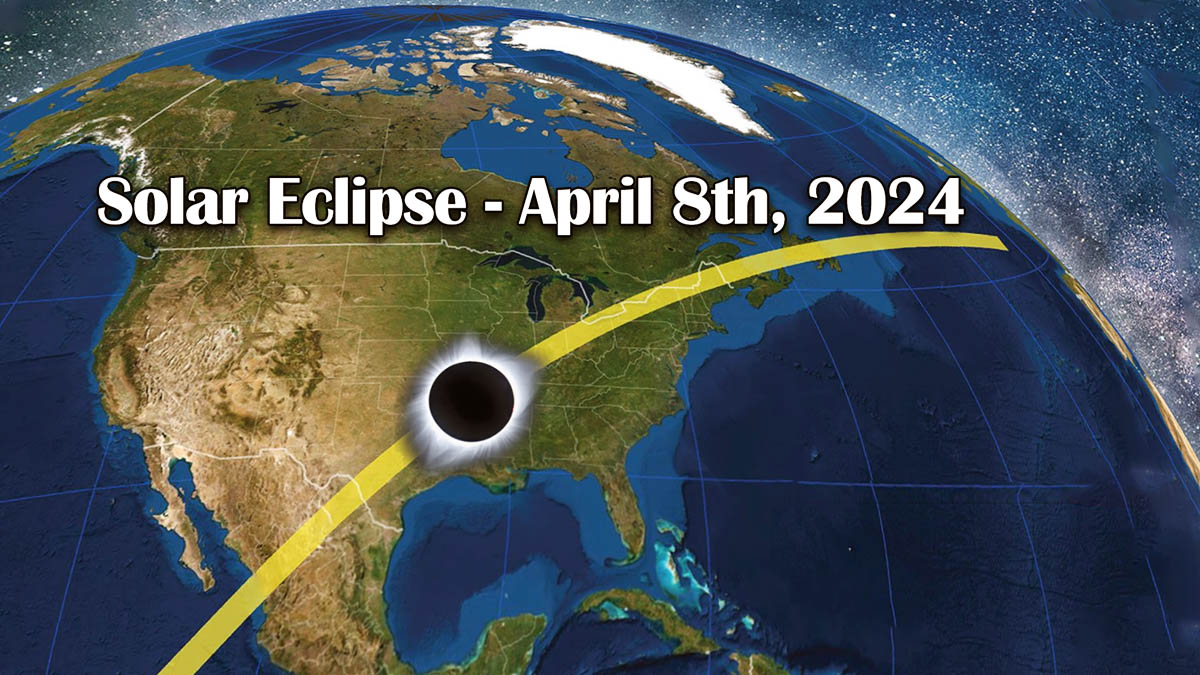
The April 8th total solar eclipse will be visible also from several large cities in Mexico, the United States, and Canada. The path of totality, where the Moon will completely obscure the sun, will cross the following cities:
- Mazatlán, Sinaloa, Mexico
- Piedras Negras, Coahuila, Mexico
- San Antonio, Texas, U.S.
- Dallas-Fort Worth Metroplex, Texas, U.S.
- Austin, Texas, U.S.
- Indianapolis, Indiana, U.S.
- Cleveland, Ohio, U.S.
- Buffalo, New York, U.S.
- Little Rock, Arkansas, U.S.
- Montréal, Quebec, Canada
The cities above will be top-rated destinations for eclipse watchers. Expect millions of people to witness the eclipse from within the path of totality, making many roads and parks crowded.
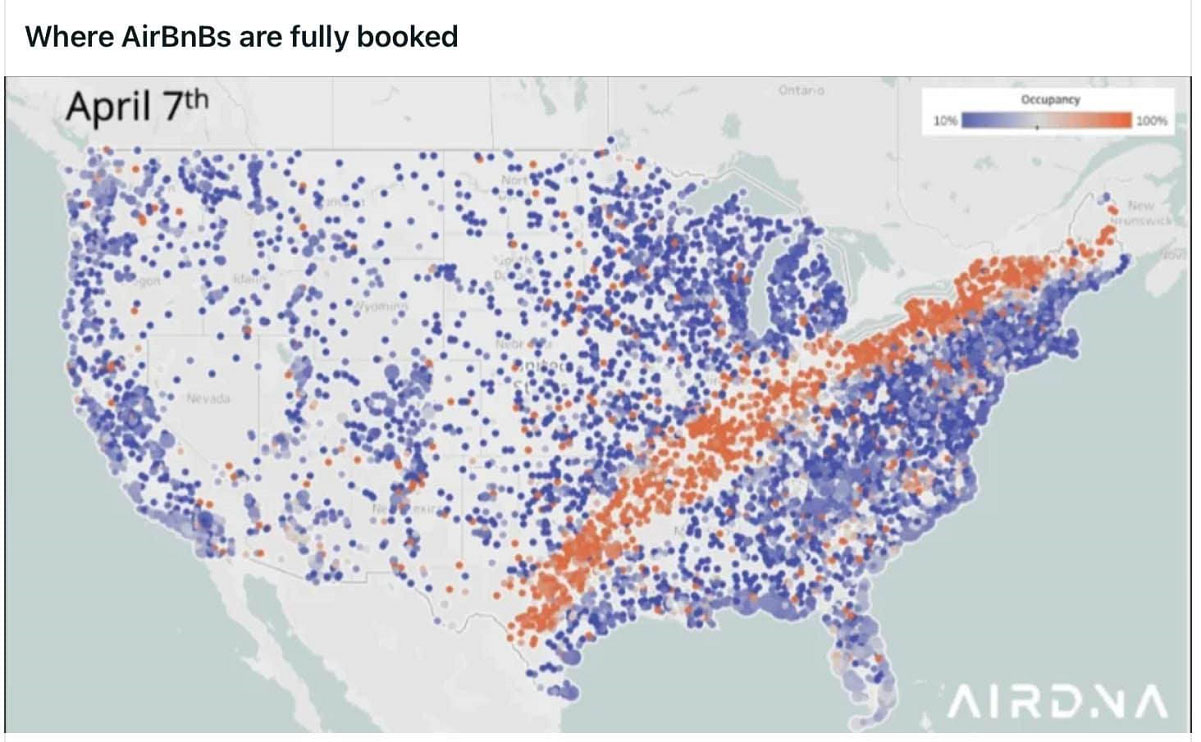
Above: An impressive image of fully booked AirBnB places across the United States, the density reveals where the totality path is. Image: AIRDNA
Here are some tips for viewing the 2024 solar eclipse in big cities:
- Make sure to be on the path of totality: To see the total solar eclipse, you must be on the path of totality. You can use Google Maps or other tools to find the exact path and plan travel accordingly.
- Plan: Hotels and campsites near the path of totality book up quickly, so you are advised to make your reservations early.
- Check the weather: Look for the local weather office for locations with the best chance of clear skies during the eclipse.
- Get eclipse glasses: You must protect your eyes by using eclipse glasses or other approved solar filters.
- Use colanders or slotted spoons: These excellent items can create exciting shadow patterns during the eclipse.
- Find a sunny location: Make sure you have a clear view of the Sun during the eclipse; you don’t want to miss the most important few minutes of totality.
- Use a telescope: If you can access a telescope with a safe solar filter, you can get a closer view of the eclipse phases.
- Watch the live stream: If you cannot reach the path of totality, you can still watch the eclipse online. There will be plenty of live streams on YouTube.
- Share the epic event fun: Host an eclipse-watching party for your friends and family.
- Be patient: Road traffic in the cities and crowds can be a real challenge. Plan accordingly and be patient.
The last Total Solar Eclipse happening across the United States was the Great American Eclipse on the 20th of August, 2017. It was the most-watched eclipse event in human history.

Above: Total Solar Eclipse in Wyoming, US on Aug 20th, 2017. Photo by Marko Korosec
Remember, the total solar eclipse is a rare and spectacular event – so take the time to plan and enjoy it safely!
What is the Solar Eclipse?
The total solar eclipse forms when the Sun, Moon, and Earth are aligned. This happens when the Moon passes between the Sun and Earth and completely blocks the face of the Sun, as seen from Earth. These objects’ alignment results in the Moon casting a shadow on the Earth, thus creating a temporary darkness in the path of totality. The Moon entirely obscures the Sun in front of it.
If we want to see a total solar eclipse, the Moon, the Sun, and the Earth must all line up so that the Moon completely blocks out the sun for viewers on the part of the Earth’s surface. Below is a conceptual diagram explaining how the solar eclipse occurs.

Earth residents are fortunate to be able to see total solar eclipses. As we can see from the image above, many factors need to align for an eclipse to happen. The moon needs to be just the right size and distance from Earth so that its shadow cast appears on the surface. A minor difference in the moon’s orbit wouldn’t bring the eclipse.
The inner dark circle of the Moon’s shadow, the umbra, is where the eclipse has a total phase. The outer circle, the penumbra, is where a partial eclipse occurs.
To witness the full effect of a total solar eclipse, one must be within the path of totality. The sky darkens, temperatures drop, and the Sun’s corona becomes visible.
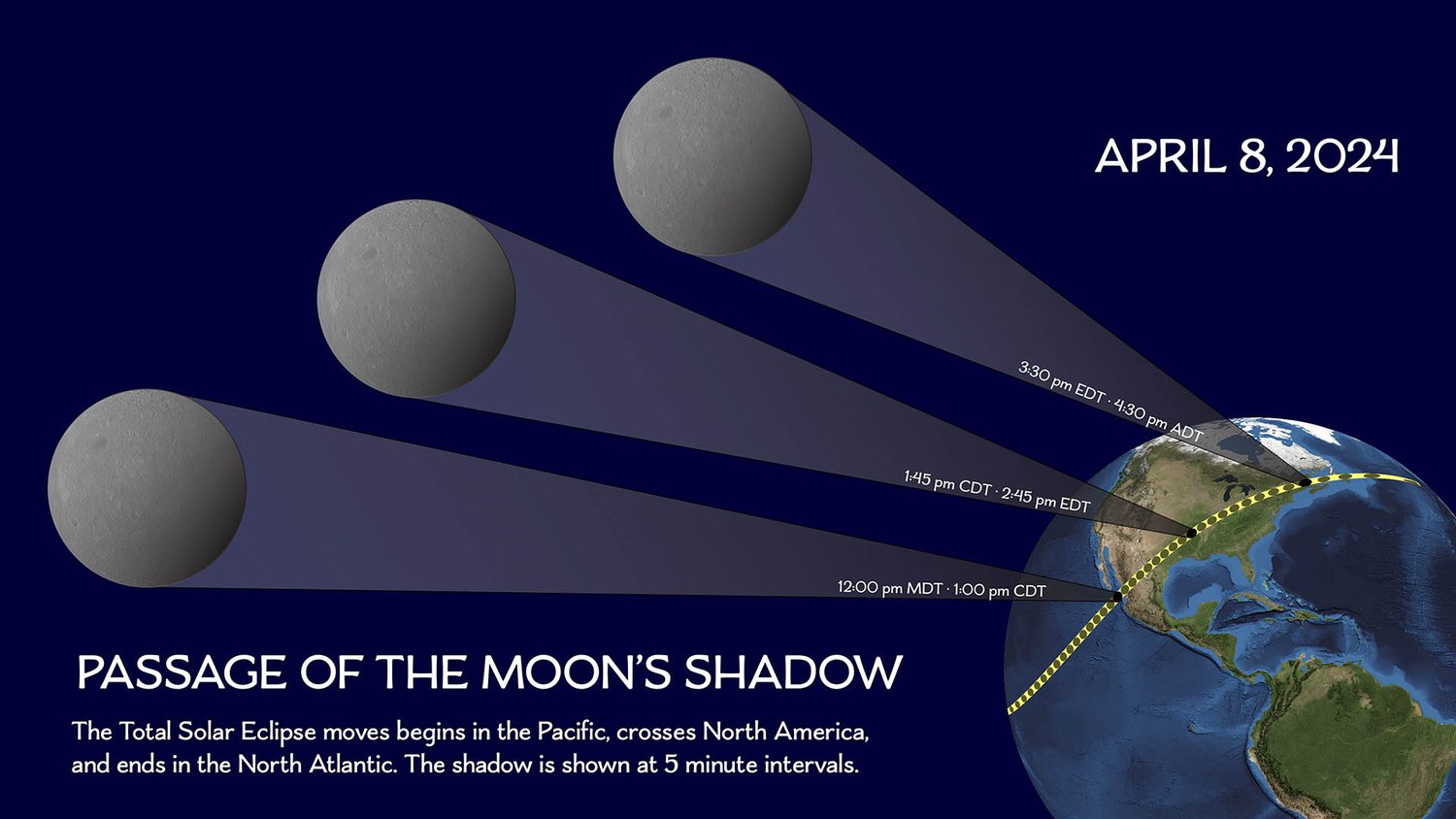
Above: April 8th passage of the Moon’s shadow across North America, with local times. Image: Great American Eclipse
This rare but spectacular celestial event offers a unique opportunity to observe the Sun’s outer atmosphere, the corona. Usually, the corona is obscured by the Sun’s brightness. Remember that it is crucial to use approved protective eyewear when viewing a solar eclipse to prevent significant eye damage.
Total solar eclipses occur about once every 18 months on average, and they are not visible from the exact location on Earth each time, which makes this event extremely rare. The path of totality, where the Moon completely covers the Sun, is only about 60-70 miles wide. The Moon’s shadow moves across the Earth at high speed along this totality path.
The main difference is that the Moon doesn’t orbit the Earth in a perfect circle. Instead, It travels in an elliptic orbit, sometimes bringing it closer to or farther from Earth.
When the moon is in the apogee position, it is known as the Micro moon event. When the perigee occurs, it is known as the Supermoon. The moon can be up to 15% bigger and up to 30% brighter when a supermoon occurs.
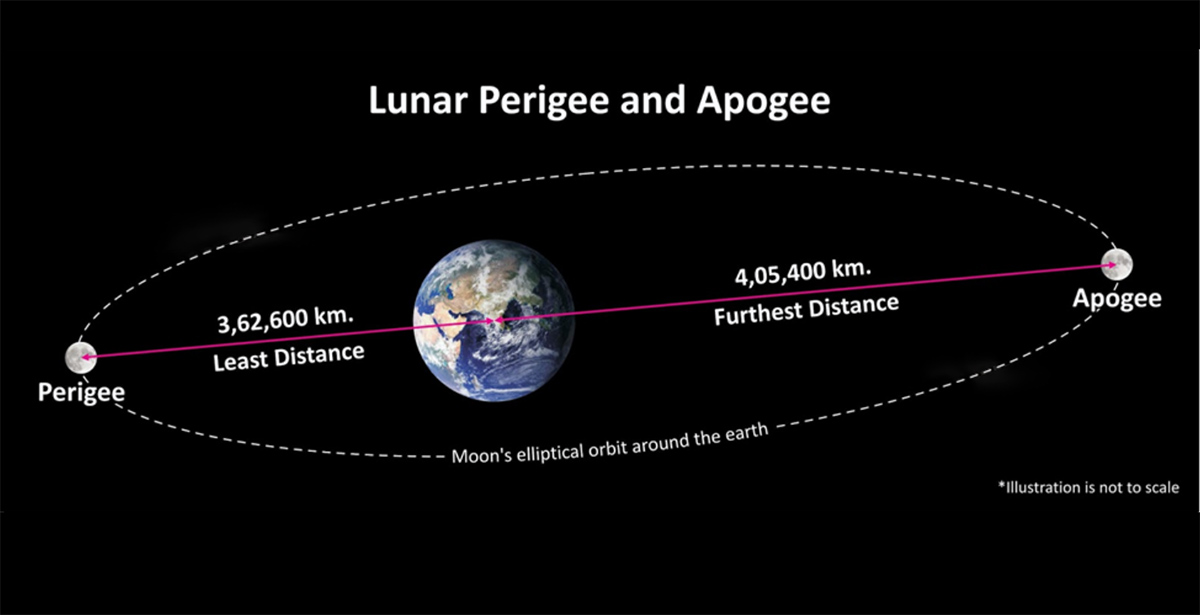
Note: Thanks to the geometry of eclipses, total solar eclipses are strongly localized and are very short-term events. Therefore, the Moon’s shadow is pretty narrow when it reaches the Earth’s surface. This means that areas where the total or annular eclipse is visible are also tiny and last only a couple of minutes at maximum.
The Moon’s umbral shadow is approximately 165 miles (267 km) across the Earth. Totality lasts about 7.5 minutes, with the shadow racing from west to east. So, the patch of fast-moving darkness across Earth’s surface only brings a swath of totality for people watching the solar eclipse within this narrow band.
For those observing outside the path of totality, the moon covers only a portion of the sun, so they will only see a partial eclipse.
Aside note: In the far future, about 600 million years from now, observers on Earth will not be able to see total solar eclipses anymore. This is because our Moon is slowly but gradually moving away from the Earth. So, at some point, the total solar eclipse will no longer be visible from the Earth’s surface, and the Moon will cover even less of the Sun’s disc.
But don’t worry—there will be plenty of solar eclipses in the coming years and decades for people living in this century.
Detailed charts for Total Solar Eclipse Path
Next, we will share details of the total solar eclipse’s path across Mexico, the United States, and Maritime Canada.
Central Mexico
The partial eclipse begins the moment the edge of the Moon touches the edge of the Sun; this is called the first contact. So, the first contact in Mazatlan, Mexico, occurs at 09:51:23 a.m. local time. The totality begins at 11:07:25 a.m. and lasts 4 minutes and 27 seconds.
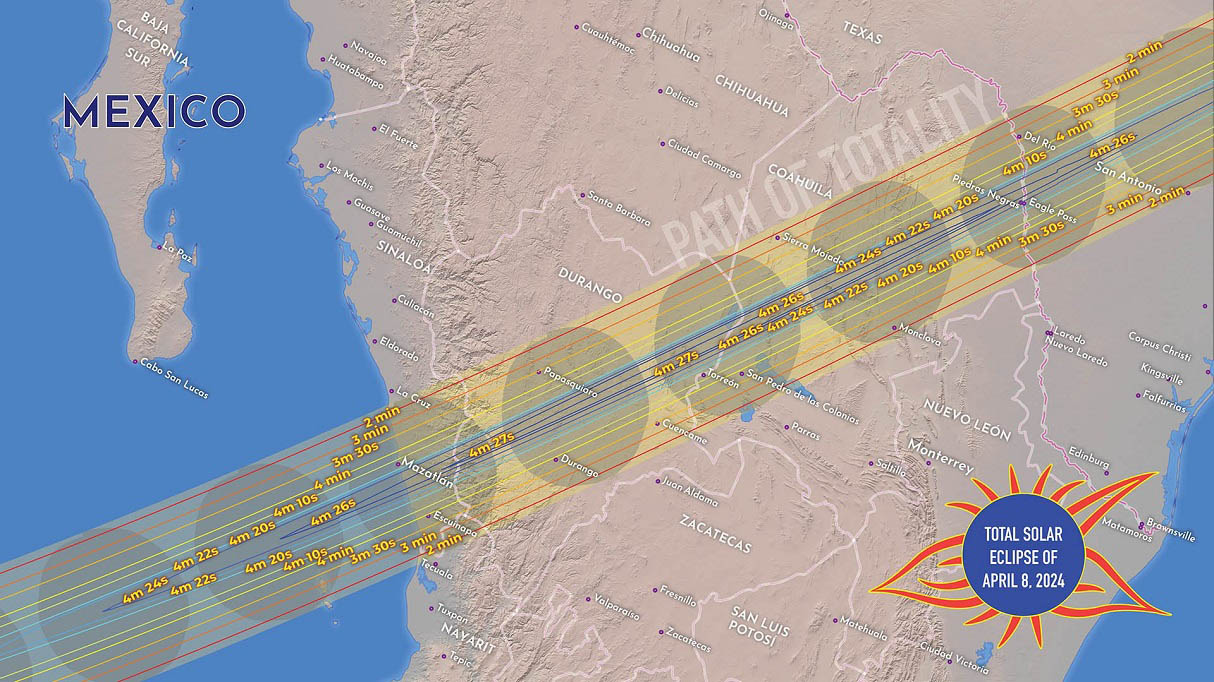
Above: Path of totality across Mexico. Image: Great American Eclipse
This will be the most prolonged duration on the North American continent for this event.
Southern Plains – Texas to Arkansas
After Mexico, the eclipse will enter southwestern Texas in Eagle Pass and continue northeast towards Dallas and Arkansas. The partial eclipse begins at 12:10:20 p.m. and about 15 minutes later in Dallas-Fort Worth.
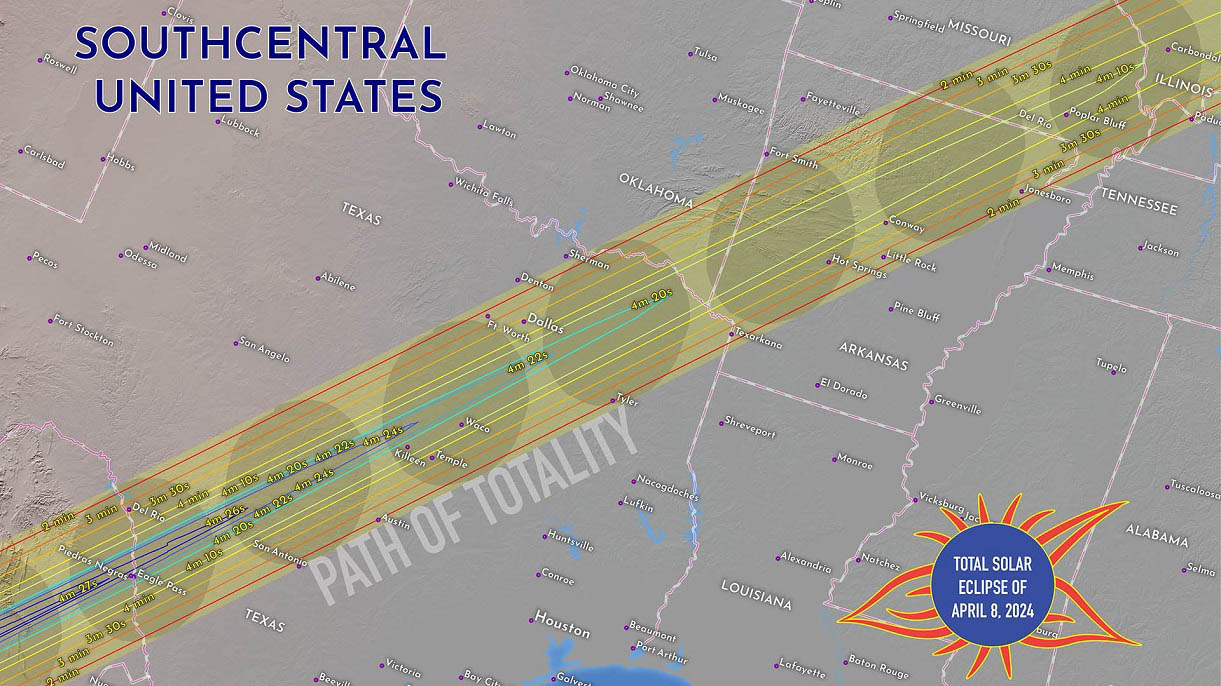
Above: Path of totality across the southern United States. Image: Great American Eclipse
The totality begins at 1:28:07 p.m. in Eagle Pass and ends at 1:40:54 p.m. in Dallas, Texas. In Texas, the totality will last 4 minutes and 25 seconds.
Ohio Valley and Ontario, Canada
Illinois: The partial eclipse will begin at 12:42 p.m., while the totality will begin at 1:59 p.m. and last for 4m and 10s.
Indiana: The partial eclipse will begin at 1:47 p.m., while the totality will last 4m and 4s and begin at 2:02 p.m.

Above: Path of totality across Ohio Valley and Ontario, Canada. Image: Great American Eclipse
Ohio: The partial eclipse will begin at 1:53 p.m., while the totality will last 4 minutes and begin at 3:08 p.m.
Ontario, Canada: The partial eclipse will begin at 1:58 p.m., while the totality will begin at 3:13 p.m. and last for 3m and 53s.
Maine and Eastern/Maritime Canada
The solar eclipse begins at 2:04 pm in western New York state, with the totality at 3:18 pm, lasting for 3m and 46 seconds. Toronto will be just on the northern edge of the totality.
Vermont: The partial eclipse will begin at 2:14 pm, while the totality begins at 3:26 pm and lasts for 3m and 34 seconds.

Above: Path of totality across Maine and Maritime Canada. Image: Great American Eclipse
The city of Montreal, Canada, will be just shy north of the totality centerline, thus experiencing a total eclipse lasting 2m and 15 seconds. The partial eclipse will start at 2:14 p.m., and the totality will start at 3:26 p.m.
The eclipse path will start at 2:18 p.m. in Maine and reach totality at 3:29 p.m., lasting 3m and 28 seconds.
New Brunswick will see the beginning of the partial eclipse at 3:22 p.m. and the totality at 4:32 p.m. The total eclipse will last 3m and 22 seconds.
Newfoundland and Labrador will be the last land areas to experience the total solar eclipse. The partial eclipse begins at 4:03 p.m., while the totality begins at 5:10 p.m. and lasts 3 minutes and 3 seconds.
The eclipse will exit North America and finish in the North Atlantic at sunset.
The partial eclipse from the Azores, Ireland, Scotland, Faroe Islands, Iceland, and Greenland will also be visible.
How is the weather forecast? Will and where will the sky be clear enough to observe the eclipse?
Below is the latest ensemble multi-model cloud cover forecast for Mexico, the United States, Mexico, and Maritime Canada. This time, the eclipse visibility will be challenging, with higher odds of clouds disturbing observation in many areas and cities along the totality path.
According to the latest weather model guidance, clouds will be present across the southern U.S., especially across Texas to the lower-mid Mississippi Valley and towards the Ohio Valley. However, there are higher chances of relatively clear skies for the totality across Indiana and Illinois.

Above: Cloud coverage and rainfall potential across North America. Image: Tomer Burg
Very promising observations are forecast for the far northern U.S. and maritime Canada, with Montreal having excellent conditions. Conditions will also be very good to excellent across Mexico, so viewers should enjoy the solar eclipse event.
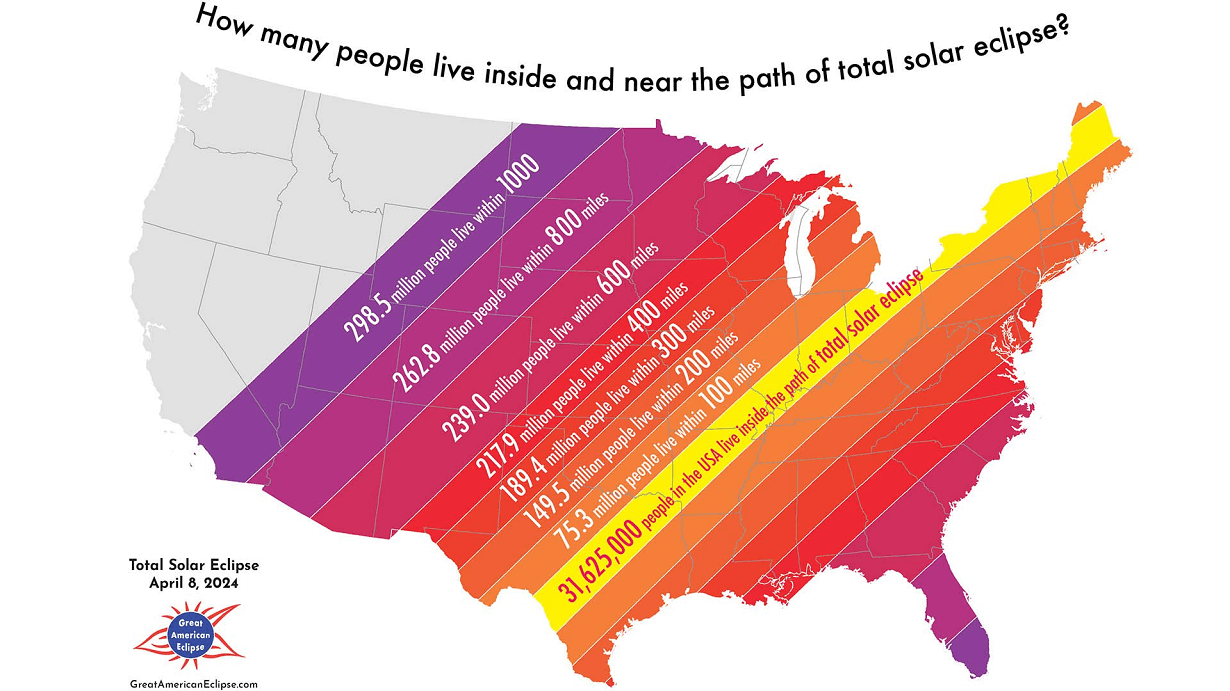
Above: Number of people living inside or near the solar eclipse path. Image: Great American Eclipse
Here is how to photograph a solar eclipse:
Photographing the eclipse might sound challenging, but it is relatively easy. First, remember to *always* use protective solar filters for your camera, telescope, or binoculars.
Solar glasses and lens protection
Eclipse glasses will allow you to view the eclipse with your own eyes. Solar protective glasses will help you better aim your camera at the Sun. When photographing the Sun (no matter the sunspots or the partial, annular, or total eclipse), you will always need a solar filter for your camera and lens.
Note: There is ONLY a short time when the solar filter is not needed during the total eclipse. This occurs when the Moon’s disc completely obscures the Sun, and we are experiencing the totality of the solar eclipse. This is not happening this Thursday, so keep that in mind.
What kind of camera do you use?
You do not need a special or professional camera to photograph the eclipse. Every camera on the market nowadays will do it. You need protection for the camera, especially your eyes.
The main difference a camera would make is the advantage of using a crop sensor camera versus a full-frame camera. The focal length multiplier effect (typically around 1.6x) with the crop cameras results in a more extensive eclipse on the pictures at the same focal length. You are getting a bigger (closer) look at the photographed object.
Which camera lens to choose?
First, it depends on what kind of photograph you want to achieve. If you would also like to include the landscape in the photo, then it is advised to use a comprehensive or even ultra-wide lens (e.g., 14-24 mm). The Sun, however, will only be a tiny dot in your photo, but it can be a great addition to your final composition.

Above: The size of the eclipse depending on the focal length
You must use a zoom lens to have more detailed zoomed-in shots. A 200-600 mm lens could give you pretty good results; the longer the lens, the better—the larger the Sun will appear. Another significant challenge is capturing all the eclipse phases with the zoom lens.
Experiment differently; you should come out with great results, nevertheless.
Use a tripod with a shutter release.
The Sun is very bright, so you can take photographs without putting the camera on a tripod. The shutter speeds are short (fast), so photographs shouldn’t be shaken. But it is always advised to use it—better be safe than sorry.
Use a remote shutter release when taking photographs. When the Moon obscures a large part of the Sun, it quickly gets quite dark so that the shutter speeds will become longer, and you would typically use a remote shutter release to trigger your camera. You can use a remote with a cable release, electronic release, intervalometer, or mobile device.
All that helps to prevent camera shake and blurring of your images at the end. We want to have sharp photos at any time! Nothing is more frustrating than the ruined sharpness of the eclipse.
Note (although not in this case): The Sun is blocked completely when you take photos during the total eclipse. This means you are photographing in complete darkness, so a sturdy tripod is a must-have during the totality.
Final words – the Basic settings
Here are some basic settings that should normally work, although be always prepared to experiment with the settings around these basic ones. Using bracketing (taking consecutive photographs with different exposures) is helpful, too, so you can experience the proper exposure.
- Use RAW format: Avoid shooting in JPEG format. When you shoot in RAW, the photograph collects much more data, which we can use to improve post-processing work later.
- ISO sensitivity: Use a native ISO; most cameras have it at ISO 100. This will give you great-quality photographs and prevent image noise. Use higher values, e.g., 200-400 ISO only if needed, as ISO 100 is preferred given that plenty of light is still available.
- Higher F Stop (Aperture): When photographing the eclipse, we should close the lens’s Aperture (F Stop) to f/8 or even down to f/11. These are the most preferred settings when you are also doing the close-up shooting of the different solar eclipse phases.
- Shutter Speed: If we use ISO 100 and Aperture settings between f/8 to f/11, the shutter speed from 1/500s to 1/1000s will generally do the best results. Indeed, experiment with the shutter speed settings, which will expose the photograph correctly.
Tips on how to observe solar eclipse safely
Never observe the Sun with an unaided eye.

Above: A Ring Of Fire solar eclipse in Texas, May 20th, 2012. Photo by Marko Korosec
Even if you plan to observe the solar eclipse, you should buy protective solar glasses. You want to avoid messing around with the dangerous light from the Sun. The damage can happen in seconds and even make you blind if unlucky. So, here are some tips on observing the event as safely as possible.
We must always use solar glasses to protect our eyes when observing the Sun, whether during full daytime or eclipse events. The solar glasses (or filters) should not have scratches, punctures, torn, or damage. If you find any of those on, throw them away and buy a new one. No exception, seriously.
If you plan to observe the eclipse with your children, always help and supervise them while they wear solar glasses. Although it is a unique opportunity for us all, the wrong moment could damage their eyes permanently.
Also, if you usually wear glasses, put your eclipse glasses on over them. Or hold your handheld filter in front of them.
Also, do not look at the Sun through a camera, a telescope, binoculars, or any other optical device while using your eclipse glasses or handheld solar viewer. The uneclipsed or partially eclipsed sun through an unfiltered camera, telescope, binoculars, or another optical device should never be done.
When are the next total solar eclipses?
If you are unlucky and have a cloudy day, there will, fortunately, be more opportunities in the coming years. Although you might need to travel to some parts of your country or continents, it is worth a shot to experience this unique lifetime opportunity.

Above: Annular and Total Eclipses around the world between 2020 and 2029. Image: Timeanddate.com
The next full total Solar Eclipse will occur in Europe on August 12, 2026. The swath of totality will sweep through the western Mediterranean, Spain, and across the northeast Atlantic to western Iceland and eastern Greenland. The partial eclipse will be seen across most of Europe.
It is challenging for eclipses to visit the same places (or countries) worldwide. They might happen just once in a century. So, if you are dedicated to seeing one, some travel will be needed to catch the next one unless you are lucky enough to live on its exact track.
For those who live in Mexico, Ohio Valley, and maritime Canada, Monday’s total solar eclipse will be quite a spectacular event. Millions along the path of totality, including Montreal, Canada, will see it as our Moon moves across the Sun.
Solar Eclipses occur only about twice a year, each unique. They occur in different, often remote areas, and many people travel worldwide to experience this spectacular celestial event. Total eclipses happen even more rarely, about every 18 months.
Those of us who have already experienced a solar eclipse can tell you it is such a special event that you remember it forever. When a total eclipse occurs, the Sun is completely obscured by the Moon during the daytime. But an even more spectacular and rare event is an annular solar eclipse.
See also: